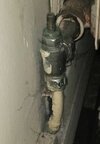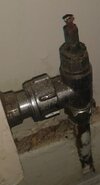Hi
I have a Greenstar 24i Junior combi boiler and a central heating system with a radiator in the bathroom, living room, dining room/kitchen and each of the three bedrooms.
All the radiators have TRVs except the ones in the living room, dining room/kitchen and bathroom. The dining room has valves as shown below on the left and right of the radiator. (I think these are lockshield valves.)
The living room radiator is 75cm wide while the dining one is 150cm wide. This means the dining area tends to get too warm as it has a bigger radiator. The thermostat's in the living room.
Would it be possible to adjust the valves on the dining room radiator to turn it down (or even turn it off given the area usually gets warm in the evening from cooking)? If so, would I adjust the left or right one?
Thanks for any help!


I have a Greenstar 24i Junior combi boiler and a central heating system with a radiator in the bathroom, living room, dining room/kitchen and each of the three bedrooms.
All the radiators have TRVs except the ones in the living room, dining room/kitchen and bathroom. The dining room has valves as shown below on the left and right of the radiator. (I think these are lockshield valves.)
The living room radiator is 75cm wide while the dining one is 150cm wide. This means the dining area tends to get too warm as it has a bigger radiator. The thermostat's in the living room.
Would it be possible to adjust the valves on the dining room radiator to turn it down (or even turn it off given the area usually gets warm in the evening from cooking)? If so, would I adjust the left or right one?
Thanks for any help!




